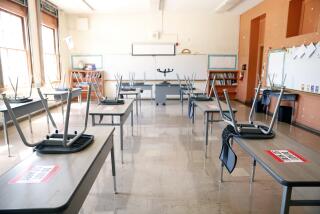Campus Crowding Can Make PE a Challenge
- Share via
On a playground at Virgil Middle School in Los Angeles, 340 red-and-white-clad children play side by side, atop a blacktop surface that seems to offer room for half that number of youngsters. Some students do jumping jacks; others shoot baskets. Some spike volleyballs; others sit on bleachers and watch.
Six teachers supervise the classes, shouting above the din that goes along with so many children in so small a space. Theirs is a tough job. And the sheer number of students puts limits on how much the teachers can do.
The teachers don’t seem to notice, for example, the girl who is faking her jumping jacks in the back row, moving her arms but not her legs, or the two boys deep in conversation during windmills, or the girl who can’t make a basket, despite countless tries. But as much as possible, the instructors offer encouragement and how-to tips.
“We’ve tried to corral them, to do good stuff with them,” said Jim Lefler, who has been teaching physical education at Virgil for four years.
Virgil, an east Hollywood school that opened in 1912, is so overcrowded that it is on a year-round, triple-track schedule, with about 1,800 of its 2,700 students on campus at any given time.
Gym classes there often exceed 70 students per teacher, and that, Lefler said, “means a little bit less teaching, and a little more organization. If you can handle it, it works out good. If you can’t, it looks like a disaster.”
Nowhere are the realities of school overcrowding more evident than in physical education, the most densely packed classes of Los Angeles Unified, the state’s most populous district.
At many Los Angeles schools, students spend a good part of their required gym class time sitting on bleachers or the blacktop, waiting for a chance to shoot a basket or run wind sprints. Scrimmage teams swell: At Virgil, a volleyball game had 10 students per side -- four more than rules require. When children were done with classes and went back to the locker room to change out of their gym outfits, there weren’t enough lockers to accommodate them, and so students had to share.
Limits on class size that govern other subjects do not apply to physical education. So at L.A. Unified, according to Jeanie Leighton, district director of middle school programs, most middle school physical education classes hover between 55 and 65 students per class -- in some cases twice the size of academic classes. The crowding is worse at middle schools than high schools, because every middle school student is required to take physical education while high school students are obliged to take it only during two out of their four years.
California -- the first state in the nation to require physical education in its public schools -- has fallen behind when it comes to physical education, said Betty Hennessy, a PE specialist with the Los Angeles County office of education. National recommendations are that classes have a 25-1 ratio, and most other states approach those numbers. California’s official average is closer to 43 to 1, although some say the number may be higher.
The overcrowding and the limits on how much exercise children can get in such classes are taking a toll, Hennessy and others say. Such school-based exercise is needed more than ever because so many children are leading a sedentary lifestyle outside school and youthful obesity is becoming more of a problem, experts say.
A report issued this month by the state Department of Education, based on tests in the 2002-03 school year, concluded that 27.1% of California’s seventh-graders were deemed physically fit. In L.A. Unified, the number was even lower: Only 16% met the minimum standards to be considered fit.
Earlier this year, a district task force presented the Los Angeles school board with an eight-year plan for improving its physical education program. A main goal is to reduce class size to 55 and eventually to fewer than 37.
But even capping classes at 55 would cost the district about $6.1 million, according to district estimates, and officials say such spending is unlikely in the current tight budget climate. Only one piece of the task force’s plan -- hiring a districtwide physical education advisor -- has been adopted.
“It’s so frustrating,” said board member Marlene Canter, who has pushed the board in recent years to focus on the health and fitness of the district’s 728,000 students. “Our fitness scores are so low.... It’s not an economic issue. This is a health issue for our students.”
Hennessy said she understood what gym teachers are up against. “Managing a class of that size is a monumental task for any teacher,” she said. “Much less a teacher who must keep track of students’ medical records and individual needs.”
And so, as they summon their resources and imagination to cope, gym teachers have become masters of creativity. At Van Nuys Middle School, in a gym program that is often held up as a model within the district, teachers assign students to be “class managers” and “pod leaders” and to help teachers set up and clean up afterward. The school offers a wide range of gym classes, including yoga and circus skills, and tries to use every available space on campus.
“It’s all in the program, in how you orchestrate it,” said Van Nuys gym teacher Ed Burke. Giving students responsibility, he said, provides them with a sense of ownership for the classes and ultimately for their own physical fitness.
At Madison Middle School in North Hollywood, gym teachers use portable microphones and speakers on the field so they don’t strain their voices. At a class in which students practiced juggling and plate twirling as a way to hone their fine-motor skills, they listened attentively as their teacher’s voice boomed through the air.
Although adults can seem to find only the downside of large gym classes, many students said they saw nothing wrong with the numbers. Perhaps that’s because crowded gym classes represent the norm for them, something for which they have no comparison.
Or perhaps, like 12-year-old Yajeira Martinez, they see only the benefits of the large class size. “I think they’re OK like that,” the Virgil eighth-grader said. “You get to play together. We learn from each other.”
David Arutunyan, 13, said that in the first few weeks of school, his eighth-grade gym class at Madison was reduced from 74 to “63 or something.”
He, too, said he didn’t mind the size. “It’s like we’re all family,” he said.
But at Van Nuys, Burke said he hoped that the adults who make decisions in the district about budget priorities and class sizes will take a good look at the long-term consequences of leaving class sizes so large.
“Why is that fair to teachers and students?” he asked. “How is it going to help students with health and physical fitness issues?”
More to Read
Go beyond the scoreboard
Get the latest on L.A.'s teams in the daily Sports Report newsletter.
You may occasionally receive promotional content from the Los Angeles Times.










